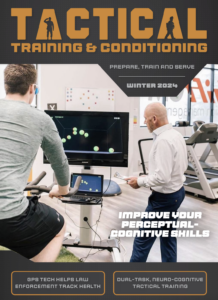Winter 2024
Dual-task, neuro-cognitive tactical training

Dual-task neuro-cognitive training is a specialized approach that integrates both physical and cognitive tasks simultaneously during training sessions. This method aims to enhance the coordination between the brain and the body, fostering a more efficient and effective response to complex situations. For tactical athletes, this training becomes particularly crucial due to the demanding nature of their tasks.
The training typically involves combining physical exercises with cognitive challenges, such as decision-making, problem-solving, or sensory perception tasks. This combination forces athletes to engage in mental processes while executing physical movements, replicating the cognitive demands of real-world tactical scenarios.
Tactical Training & Conditioning spoke with Tom West, vice president of sales at SMARTfit, to discuss dual-task training and how SMARTfit takes advantage of that type of training to help, among others, tactical athletes.
Below is an excerpt from the conversation with West, with the full conversation in the adjoining video.
On how SMARTfit utilizes gamified technology to enhance dual-task abilities…
West: I think everybody would agree that all human performance, physical, cognitive, and dual-tasking starts with the brain. We all know that there are 30 years of studies that have shown training the brain and the body together is faster, and more effective at activating neuroplasticity than doing either separately, and that applies equally to performance and recovery.
One of our clients says it very well from a recovery perspective. Dr. Chris Powers with the Movement Performance Institute in Los Angeles said, “SMARTfit takes the focus of the athlete off the mechanics and moves it to the external, forcing the brain to solve two problems at the same time. This solves the big missing part of rehab because you want carryover onto the field” in this case, the tactical field.
On how SMARTfit can be tailored to the tactical population…
West: To start, studies have shown that dual-tasking—especially if it involves executive function, in other words, the mental processes that enable us to plan, focus attention, control inhibitions, and make decisions—is effective at transferring those capabilities, even if the training activity is not specifically related to the given task.
Back to your point, as you go through these assessments, it doesn’t necessarily have to be related to a specific task. The brain takes care of that and transfers it to that capability. The specific dual-task cost assessments that we, at SMARTfit, do today are based on standard physical therapy tests—sit-to-stand, timed up-and-go, and four-stage balance tests. Our clinical team and software engineers then add cognitive tests to those. When you do them together, there’s invariably a loss in performance or “cost.” We measure that cost in specific physical and cognitive domains, and that allows the therapists and trainers to customize their training with suggested activities to improve performance. So that covers the full range.
Now, all that said, we, as a company, are cognizant of the fact that the focus is on standardized tests and we need to develop more. And that will be specific to tactical athletes. So we’re working with the military in various ways to develop those additional assessments that can be used for the tactical performance.
» ALSO SEE: Longwood Univ. partners with H2F to help exercise science students
On how this technology can be beneficial to the tactical performance industry…
West: The range of benefits to the tactical operators is substantial. Everything from cognitive speed, agility, and endurance to physical speed and agility, endurance, and the ability to do both together. They can benefit from the ability to tolerate distractions both visual and cognitive, and the ability to tolerate high-pressure conditions with consequences. The system is set up to challenge the user to do all the things we’ve talked about and do it over time. It may be a three or five-minute session. By the end of that five minutes, you are really exhausted, both physically and mentally.
One of my favorite games is “Go, No, Go,” where the lights light up and you’ve got either a green symbol or a red symbol. When the green symbol lights up you hit the green symbol. But if you see the red symbol, you pull back, and if you hit the red symbol accidentally, you get penalized. So there are all kinds of ways where this applies to tactical performance.



